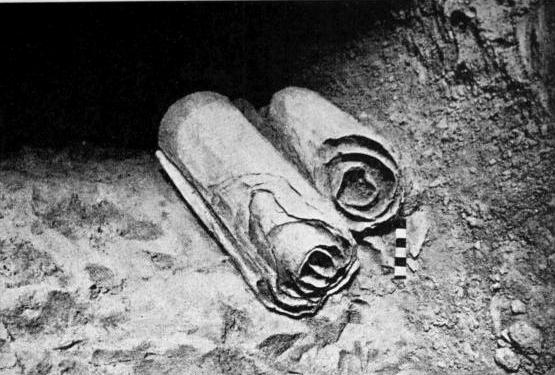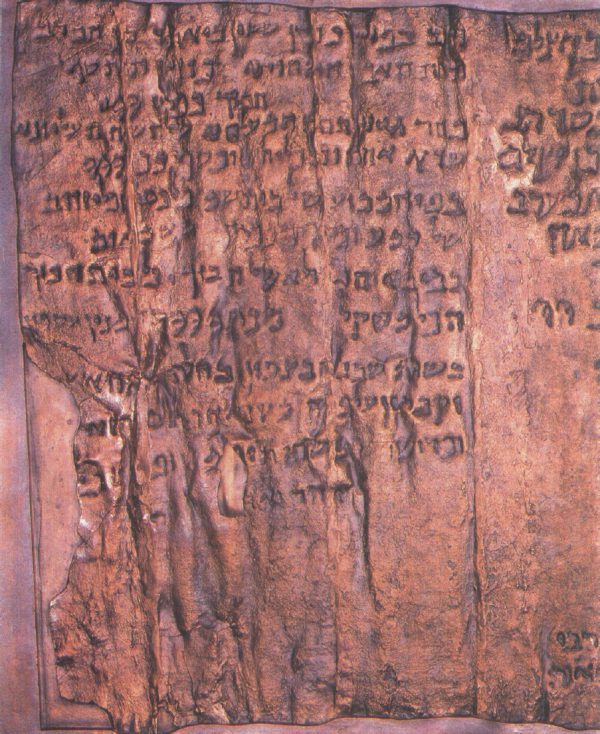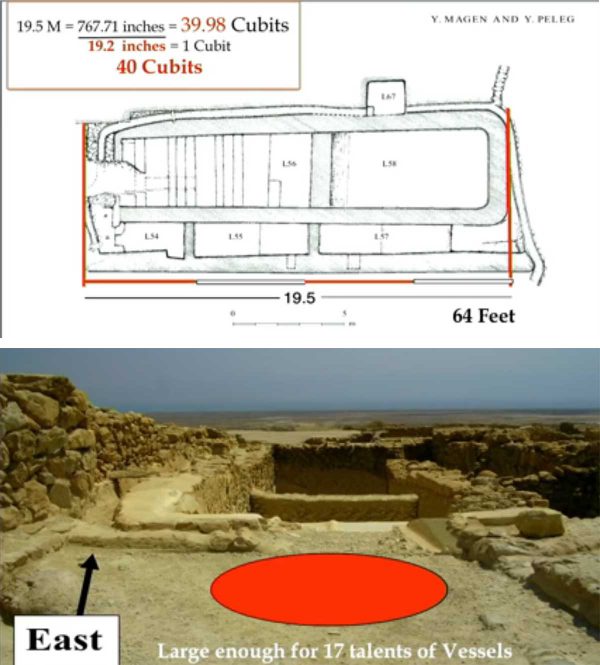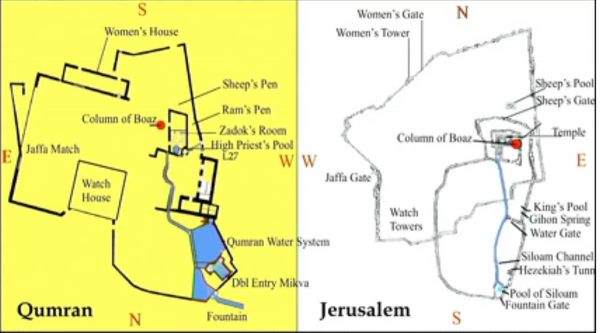
“These are the offerings you are to receive from them: gold, silver and bronze.” (Exodus 25:3)
King Solomon wrote: “There is an appointed time for everything. And there is a time for every event under heaven.” (Ecclesiastes 3:1)
Since Israel became a nation again in 1948, God has been regathering the Jewish people to His land. Is this now God’s appointed time to reveal to the world His Temple treasures, perhaps even the Ark of the Covenant itself?
Many believe that a retired American fire marshal who specialized in investigating arson crimes and won an international award for doing so has deciphered a “verbal treasure map” found in the caves of Qumran near the Dead Sea.
In 1952, five years after the first Dead Sea Scrolls were discovered in the caves of Qumran, archaeologists from the Israel Antiquities Authority (IAA) continued their quest to find more literary treasures.
On their last day of excavating what is known as Cave 3, they discovered behind the jars and fragments of scrolls a wall covering another chamber.
Inside the chamber on a shelf rested two copper scrolls about one foot wide.
Exposed to the weather for centuries, the scrolls were badly oxidized and brittle to the touch, but mostly intact. The words dig, cubits and gold could be repeatedly seen through the outer layer.

The Copper Scrolls as found in Cave 3. They are the only ancient copper scrolls in existence to date.
In 1956, the Israel Antiquities Authority tasked technology professor Henry Wright Baker in England to open the scrolls. He devised a saw out of war materials and dentistry school tools and successfully sliced the two fragile scrolls into twenty-three pieces, uncovering one document over seven feet long with twelve columns of writing.
This scroll has no literary value like all the other Dead Sea Scrolls, which are written on papyrus and leather/parchment.
The writing on this metal scroll is arranged in lists of gold bars, silver vessels, treasury holdings, tithes, priestly garments, more writings, and most importantly, where to find them!

One column from a replica of the Copper Scroll. (Wikipedia)
In total, the Copper Scrolls identify 64 caches of items in 57 locations, which include about 4,500 talents of precious metals (that is 168 tons, 337,500 pounds, or 153,000 kilograms!)
One talent weighs 75 pounds or 35 kilograms. It was the largest measurement of weight in ancient Israel of the Tanakh (Old Testament), used to weigh gold and silver as in Exodus 38:24:
“All the gold that was used for the work, in all the work of the sanctuary, even the gold of the wave offering, was 29 talents and 730 shekels.”
In the Brit Chadashah (New Testament), one talent referred to the value of money, worth about 20 years of a day laborer’s wage, according to the NIV Bible.
(Some believe that the notation for “talent” is actually a symbol for the Persian weight called “karsh,” which is a fraction of a talent.)
Where Is the Treasure Buried?
Column 1, line 1 of the treasure inventory begins like this:
“In the ruin which is in the Valley of Achor …”
In the valley of Achor there are many ruins, so which one could it be?
Moreover, there is much debate about the boundaries of the Valley of Achor; but by some estimates, it could extend from north of Jericho as far south as Qumran.
The American arson investigator, Jim Barfield, believes that Qumran is in this Valley of Achor and that it is the most likely ruin to look under.
The Copper Scroll text continues: “In the ruin which is in the Valley of Achor at the steps extending eastward 40 cubits long are silver service vessels weighing seventeen talents.”
Seventeen talents is 1,275 pounds or 578 kilograms.

Two silver water and wine libation (offering) cups. (Temple Institute replicas)
Bible scholars and archaeologists have believed that this first location and the other 56 locations are scattered around the Judean hills and Jerusalem.
However, Barfield believes otherwise, Since the 1990s, he has spent thousands of hours and many years studying the Dead Sea Scrolls:
“Studying them became a compulsion,” he said. “I would read going down the road on the back of the fire truck, after lunch, and on breaks from training. After work, I stayed up late into the night, sitting in my recliner, cross referencing the Bible and the scrolls.” (The Copper Scroll Project, a book by Shelley Neese)
In 2006, after he retired and had a lot more time on his hands, another Dead Sea Scrolls enthusiast, Vendyl Jones, ignited a passion in Barfield for the Copper Scrolls.

IAA survey and photo of steps extending eastward 40 cubits. Red marks the spot where Jim Barfield believes the treasure could be buried. (Copper Scroll Project YouTube capture)
Redirecting his compulsion to the treasure inventory, Barfield investigated the first treasure location.
He found an official Israel Antiquities Authority survey of steps facing east in Qumran, which measure 39.98 cubits (767.71 inches or 1,949.98 cm). That’s pretty close to 40 cubits (768 inches or 1,950.72 cm), which is mentioned in the text of the Copper Scrolls.
After discovering this, Barfield scoured the ruins of Qumran in light of his own translation of the Copper Scrolls.
Written primarily in Hebrew with some Aramaic text, Barfield took out his Strong’s Dictionary and Concordance and translated each word on the Copper Scroll himself. This approach has angered many scholars who do not agree with some of his translations.
Nevertheless, the Israel Antiquities Authorities’ director was so impressed with Barfield’s method of identifying the treasure sites that he assigned the lead archaeologists in the region to help Barfield dig for the gold bars.
In 2009, after unearthing only three feet, a mysterious phone call from the United States halted the dig; it would not resume again.
In 2014, to reignite passion for The Copper Scroll Project as Barfield has named it, he procured an industrial strength metal detector that can identify ferrous metals (those with iron) from non-ferrous metals (gold, silver, brass, and copper) up to fifty feet deep.
Because Qumran is in Area C, according to the 1993 Oslo Accords, it is considered “disputed territory.” While Israel controls the site and claims it belongs to her, Jordan and the Palestinians claim that land belongs to them.
Barfield had a difficult time getting permits to conduct his tests. But one Israeli Knesset member, an activist for rebuilding the Third Temple on the Temple Mount, Moshe Feiglin, volunteered to use his political immunity as a Knesset member to do the scanning for him. Barfield, however, was there by his side.
The results from the scan indicate that large amounts of gold and silver await uncovering in the four locations he tested.

The graphic of the Qumran scan (above) presented by Jim Barfield at the 2018 Temple Mount Conference in Jerusalem indicates ferrous metal detected in four locations, such as L32, which contain “a treasury” and more writings, according to the copper scroll. (Copper Scroll Project YouTube capture)
Who Wrote the Copper Scroll?
Some scholars who have examined the Copper Scrolls believe the writers were a Jewish sect called the Essenes who lived in Qumran in the days of Yeshua (Jesus).
Other scholars believe they were written by followers of Bar Kochba during the time that he led the Jewish revolt against the Romans in the 2nd century AD.
Still other scholars say it was anonymously written to be mere folklore and legend.
In contrast to the majority of scholars, Barfield points to a Jewish mystical book called Emek HaMelech (Valley of the Kings) written in 1648 that identifies five men:
“These records were written by five righteous men: Shamar haLevi, Hezekiah, Zedikiyah, Haggai the Prophet, and Zechariah, son of Ido the Prophet.
“They concealed the vessels of the Temple and the wealth of the treasures that were in Jerusalem and in every place, which will not be discovered until the days of the coming of Messiah, son of David. May it be speedily in our time. Amen. And so it will be.
“These are the holy vessels and the vessels of the Temple that were in Jerusalem and in every place. They were inscribed by Shamar HaLevi and his companions on a copper scroll.”
This writing has been criticized by Jewish scholars as not lining up with traditional Jewish thought. But Barfield is holding to it as one of his sources.

High priest wearing his garment, breastplate and a blue ephod (left); a Levite (priest) wearing his traditional white garment (right) stand behind the altar of incense covered in gold.
If there is any truth to this claim, then the Copper Scrolls were written by renowned prophets and kings regarding treasures from Solomon’s Temple in the time of Babylon’s conquest.
At least one of these five men, Shamar HaLevi, was a Levite (a priest).
Only priests would have been able to handle the temple vessels and the priestly garments, such as the ephod or breastplate that the high priest wore.
And only priests (of Cohen descent such as those who are being trained in association with the Temple Institute in Jerusalem) will be able to handle these items as they come out of the ground.
Isn’t this perfect timing to find such treasures?
Where Did the Treasures Come from?
Most experts agree that if this inventory of treasure is real, then it likely came from one of the Holy “Houses” of God.
-
- The Mishkan (Tabernacle) in the wilderness was funded by plunder from the Egyptians. The people gave Moses so much of their wealth that he had to tell them to stop giving!
- Solomon’s Temple was funded by the great wealth of his father King David, the tithes of the Jewish people, and his own fortunes as the richest Israeli king who ever lived.
- The Second Temple was funded in part by the Persian King Cyrus. He allowed the Jewish people to leave Babylon in 539 BC and rebuild their Temple, returning 5,400 items, such as silver and gold bowls, pans and dishes that King Nebuchadnezzar took from Jerusalem and used in his own pagan temples. (Ezra 1:1–11)
The Second Temple was later expanded by King Herod, which he funded with Roman wealth and Jewish taxation.

Solomon’s Temple (c. 950–587 BC) was so magnificent, the Jewish people wept when the less grand Second Temple was built 500 years later.
Barfield points to the book of Second Maccabees for a possible clue to who hid what treasures and when:
“The prophet [Jeremiah], having received an oracle, ordered that the tent and the ark should follow with him, and that he went out to the mountain where Moses had gone up and had seen the inheritance of God. And Jeremiah came and found a cave, and he brought the tent and the ark and the altar of incense there, and he sealed up the entrance.
“Jeremiah also said that ‘the place shall be unknown until God gathers His people together again and shows His mercy.’” (2 Maccabees 2:4–8)
While the Copper Scrolls do not mention the Ark of the Covenant directly, Barfield believes that it does so indirectly and that along with the Ark and tent, Jeremiah hid other treasures that were in the tent.
Moreover, we are certainly in the time when God is gathering His people.
Only 71 years ago in 1948 when Israel became a nation and the Dead Sea Scrolls were being discovered, there were 600,000 Jews in Israel. Today, there are 6.7 million Jews living in the Holy Land!
Following his theory that Jeremiah hid treasures mentioned on the Copper Scroll, Barfield found a map of Jerusalem in Jeremiah’s day. (As a former US army pilot, he took great interest in maps.)
Below, it appears that Qumran is laid out exactly like Jerusalem in Jeremiah’s time, only upside down!
This idea that Qumran could be a “Jerusalem in the wilderness” as Barfield describes it supports his theory that all the Temple treasures listed on the Copper Scroll are located at Qumran.

Upside down map of Qumran ruins (left); map of Jerusalem in the days of Jeremiah (right). (Copper Scroll Project YouTube capture)
What Do We Do Now?
Though he has received much scholarly criticism for his theories and sources, Israel Antiquities Authority and other Israeli archaeologists confirm that Barfield’s research has serious potential, but they have hit a political wall when it comes to digging for gold bars or any other of the Temple treasures.
One reason is that from 1948 to 1967, Jordan occupied Biblical Judea and Samaria, including the Qumran caves. Although Israel recaptured the area in the 1967 Six Day War, the 1993 Oslo Accords designated it as Area C or “disputed territory.”
Jordan believes the land still belongs to them or at least to the Palestinians and has filed a complaint with UNESCO to obtain ownership of all the Dead Sea Scrolls that Israel possesses.
Jordan would certainly try to claim any treasure dug up at Qumran. Imagine the Arab people of Jordan owning Temple vessels and Jewish priestly garments!
Moreover, finding Temple treasures could ignite a violent holy war by Arab nations against Israel, since activists will push even harder to rebuild the Temple. In recent years, even the slightest rumor that Israel is about to rebuild a Third Temple on the Temple Mount causes riots.
On the other hand, Israel’s unofficial Sanhedrin Court and Jim Barfield hope that US President Trump will help the Jewish people retrieve any Temple treasures that exist under Qumran. They say this because many Jewish and Christian leaders have labeled him as an anointed deliverer for the Jewish people and for Jerusalem, in the line of King Cyrus.

A collector “Temple coin” minted in 2018 by the Sanhedrin depicts King Cyrus and President Trump with Cyrus’ words in Ezra 1:2: “And He charged me to build Him a house in Jerusalem.”
If the Temple treasures are indeed under Qumran and one day unearthed, Barfield says, “I want to return these items to Israel and what they do from that point is up to them.”
What happens with any Temple items will ultimately be up to God in His timing and His grand plan of redemption for mankind as we come closer to the appointed time when Yeshua (Jesus) returns.





